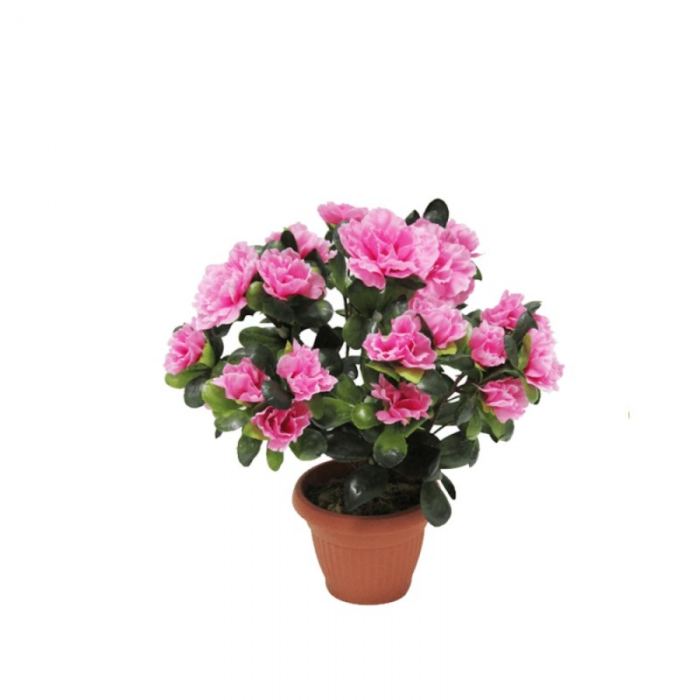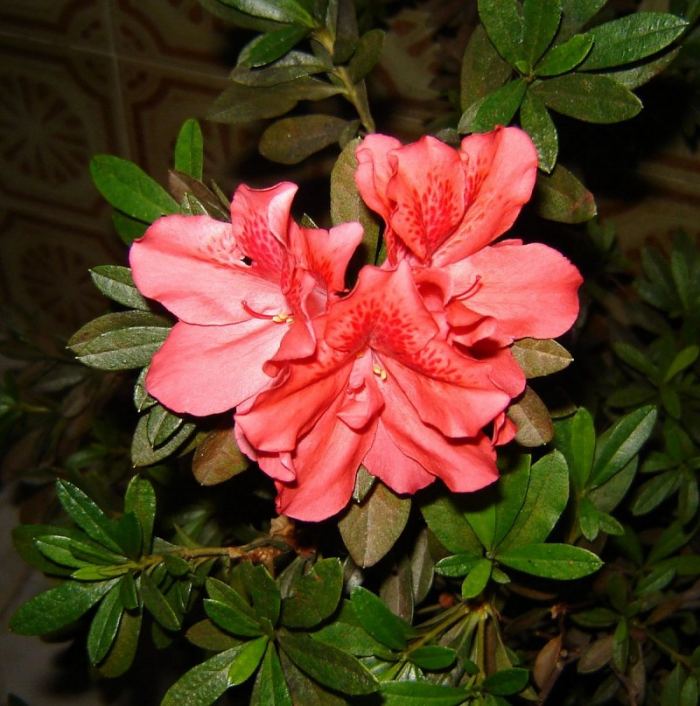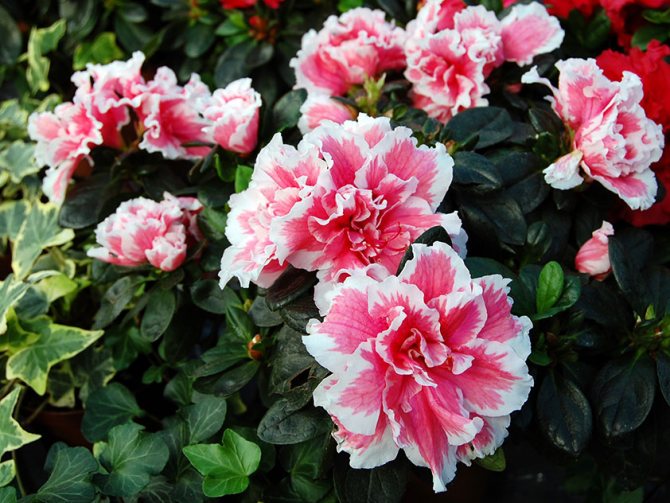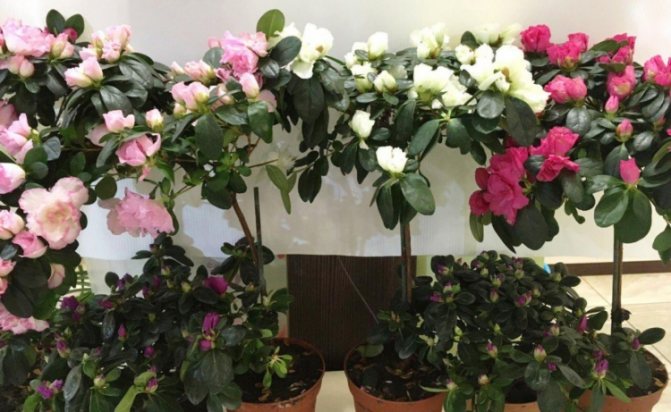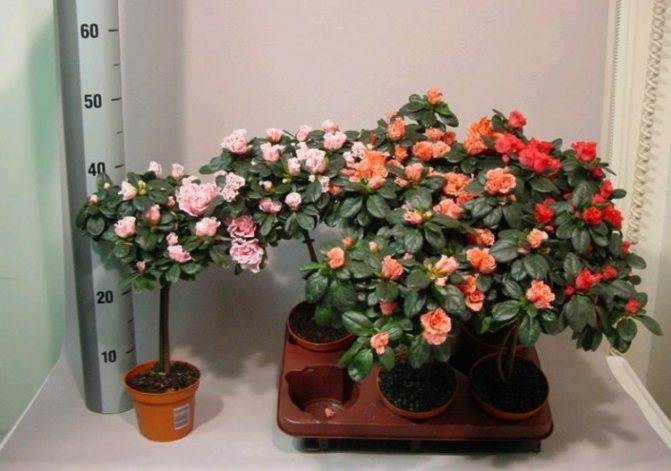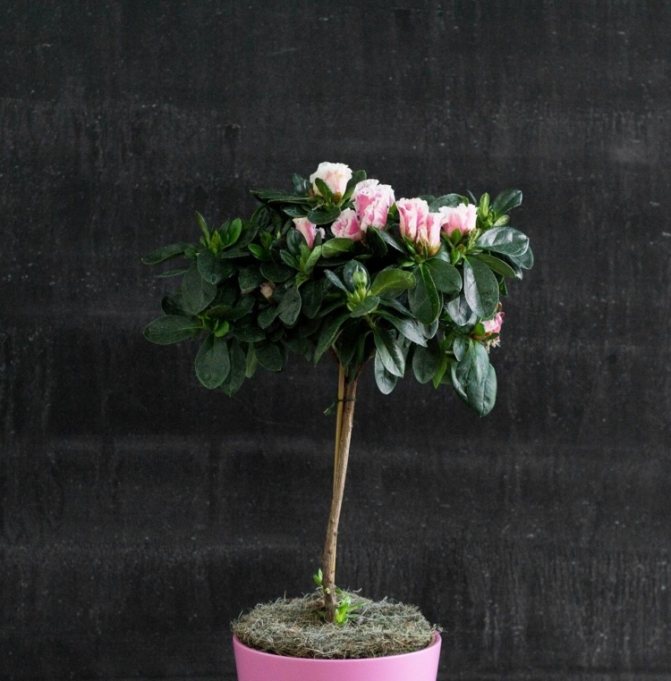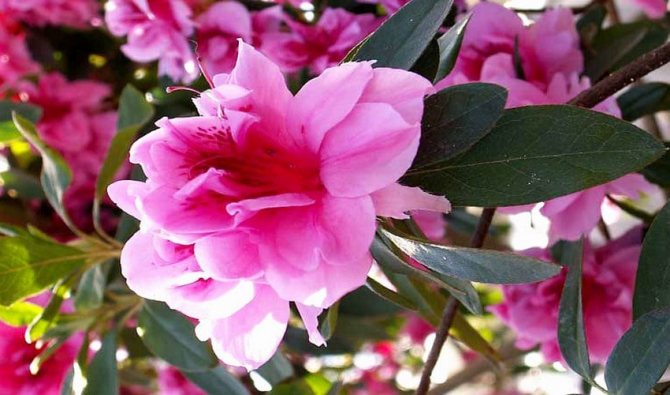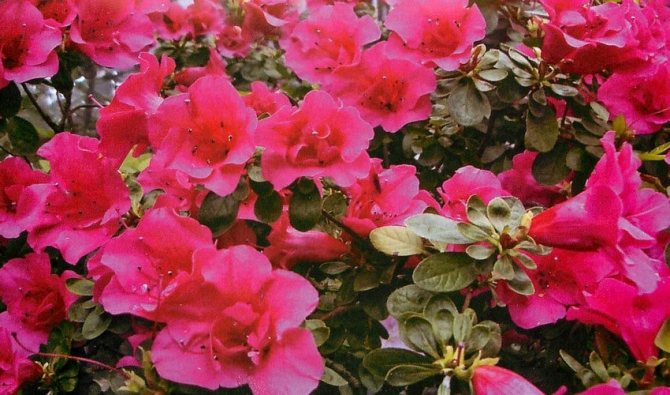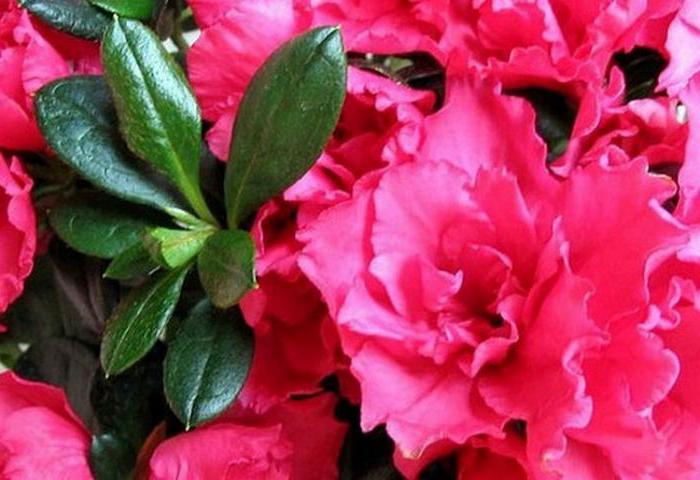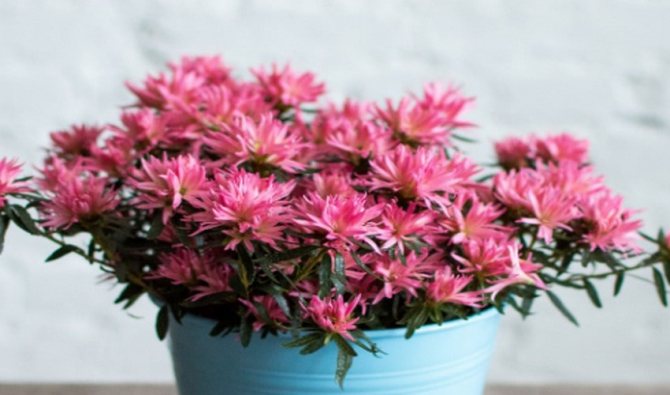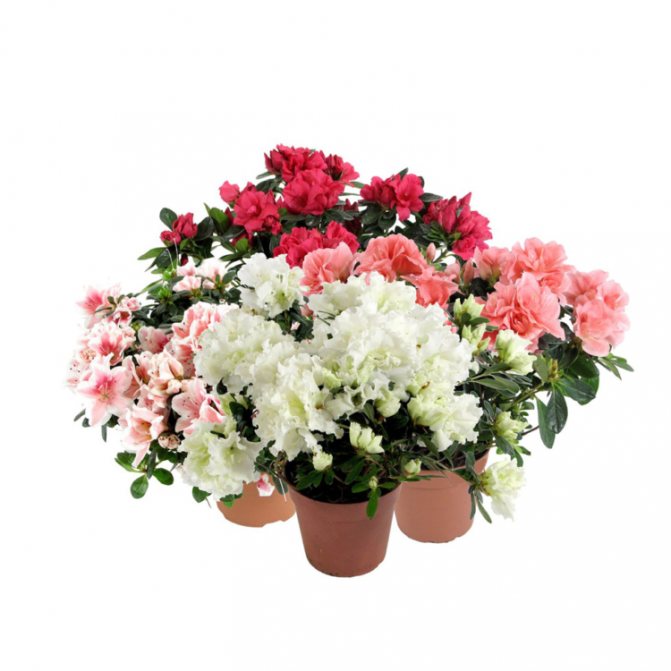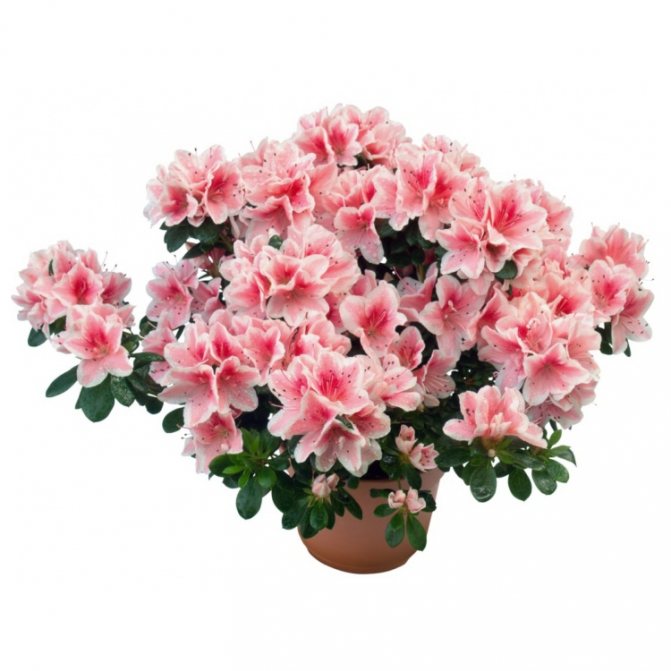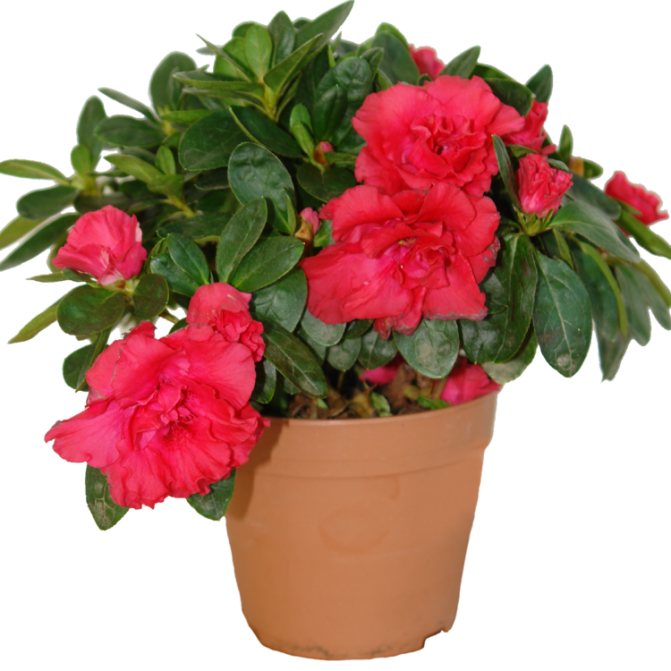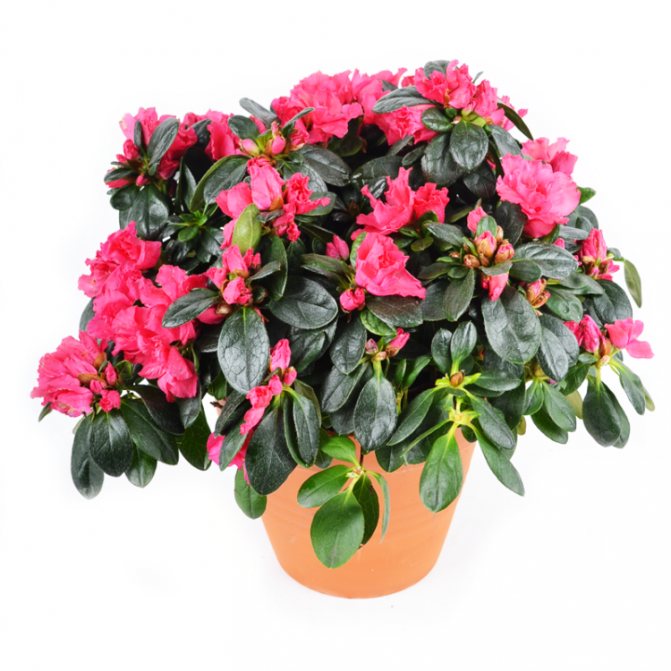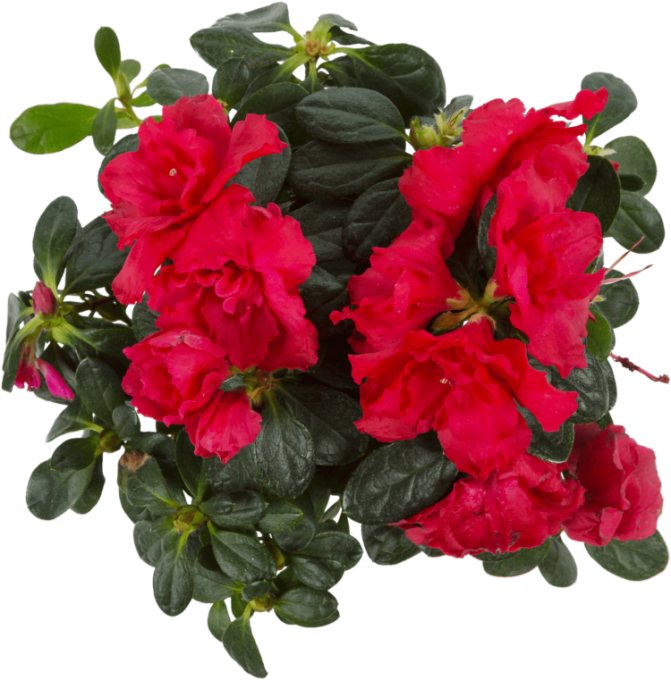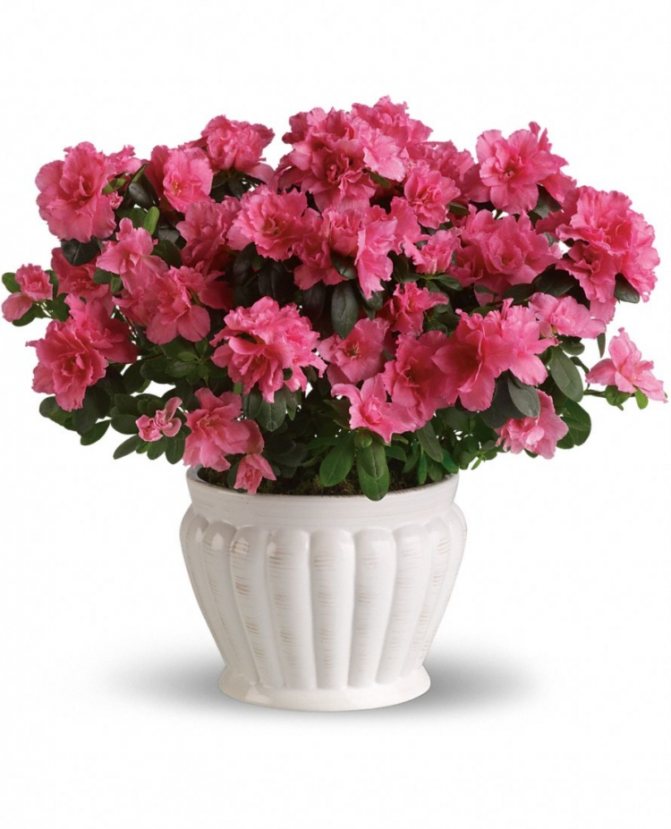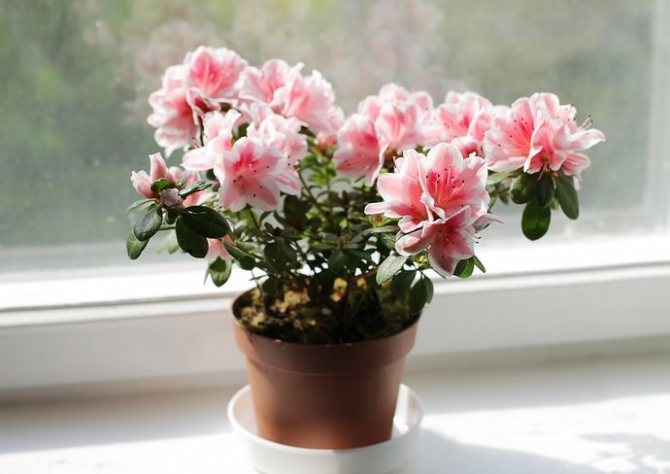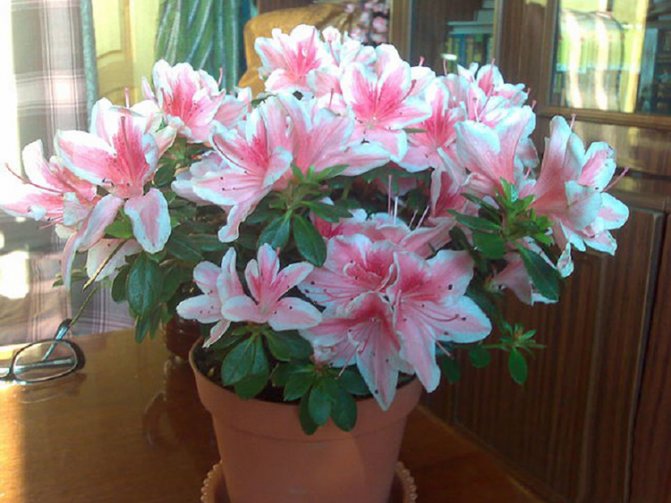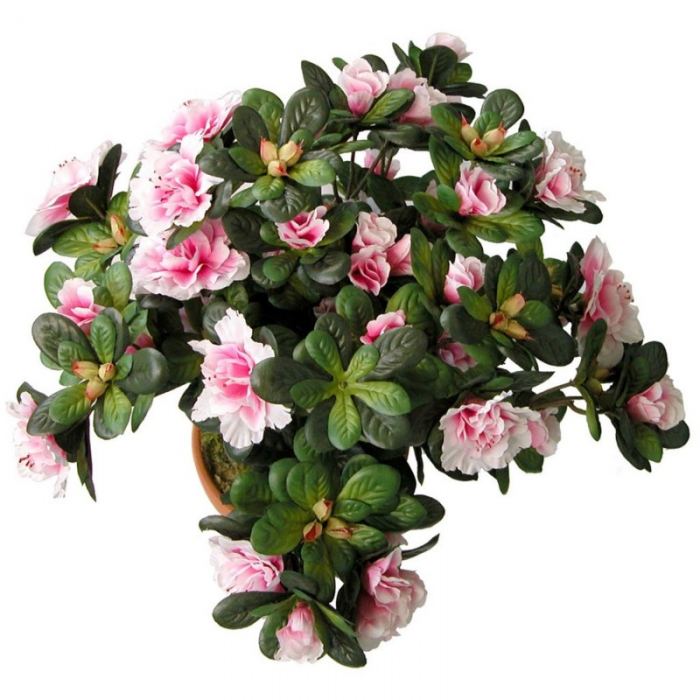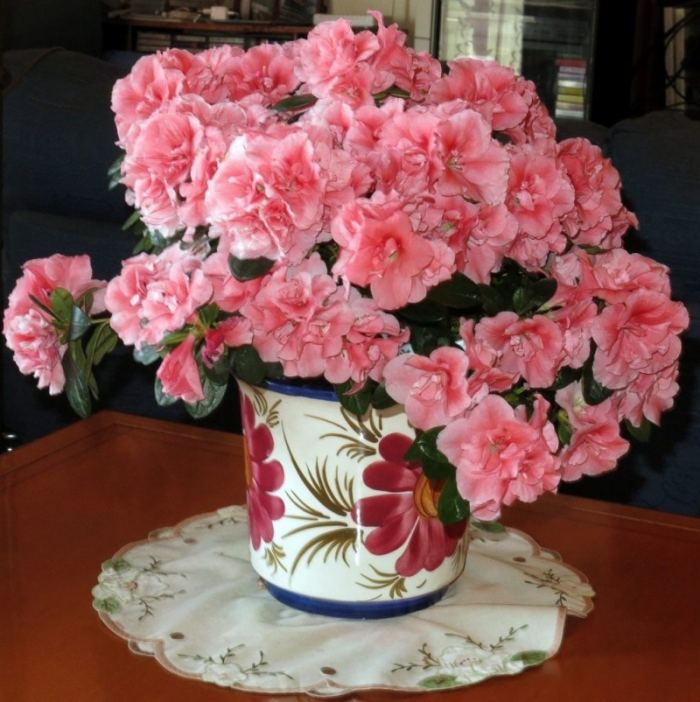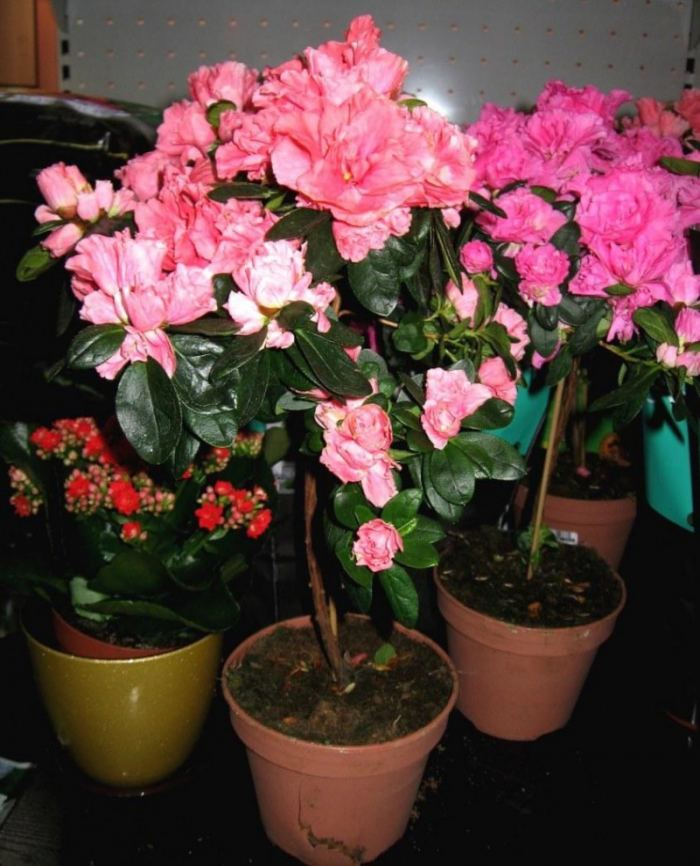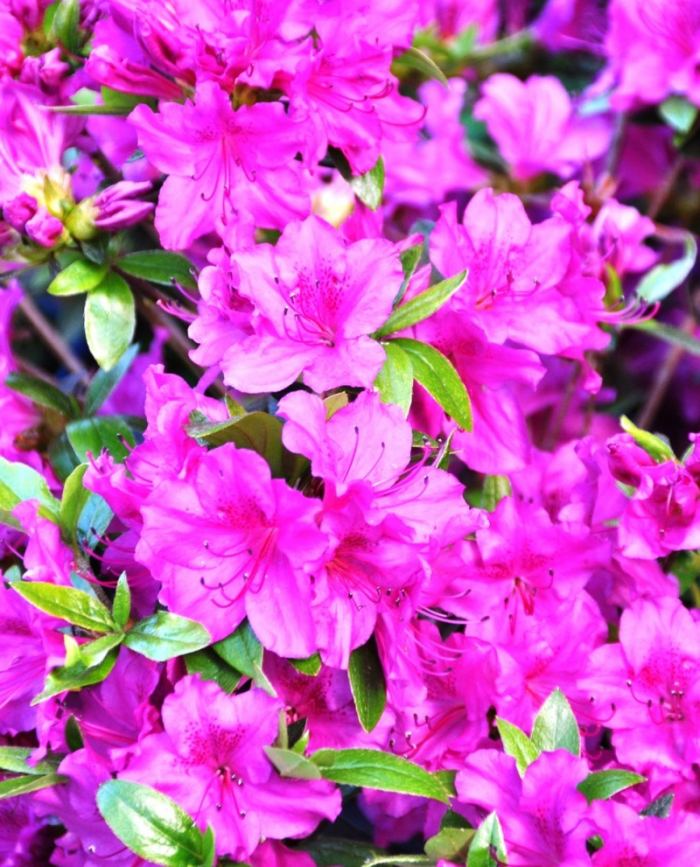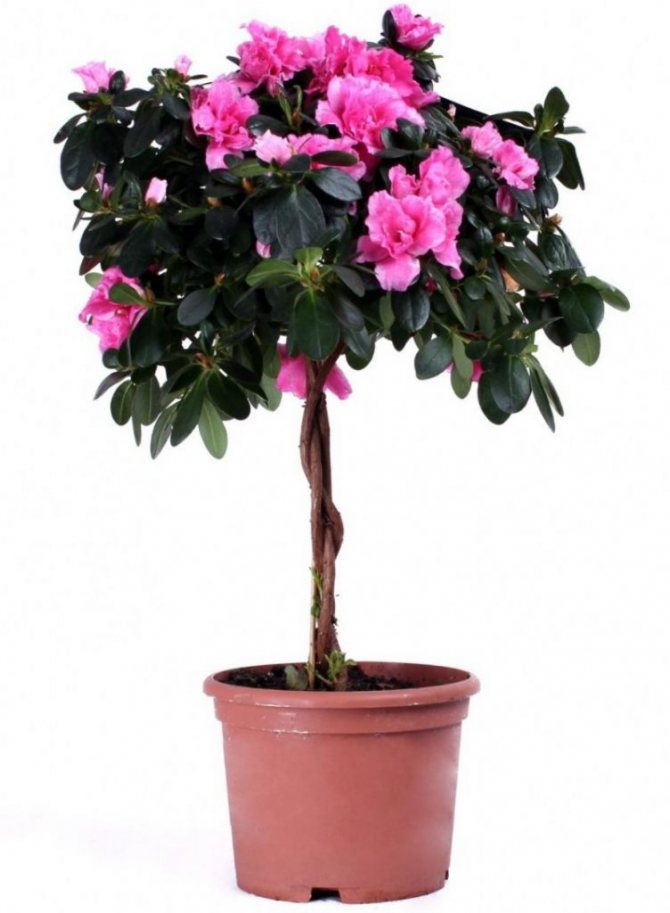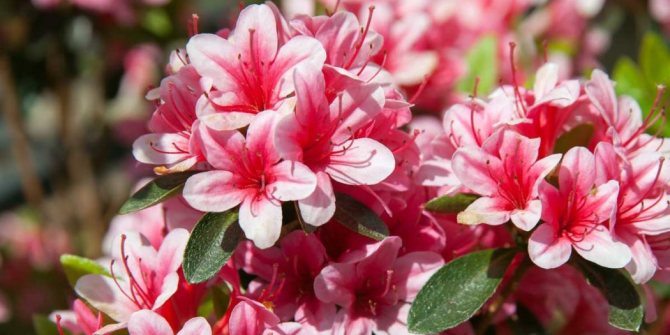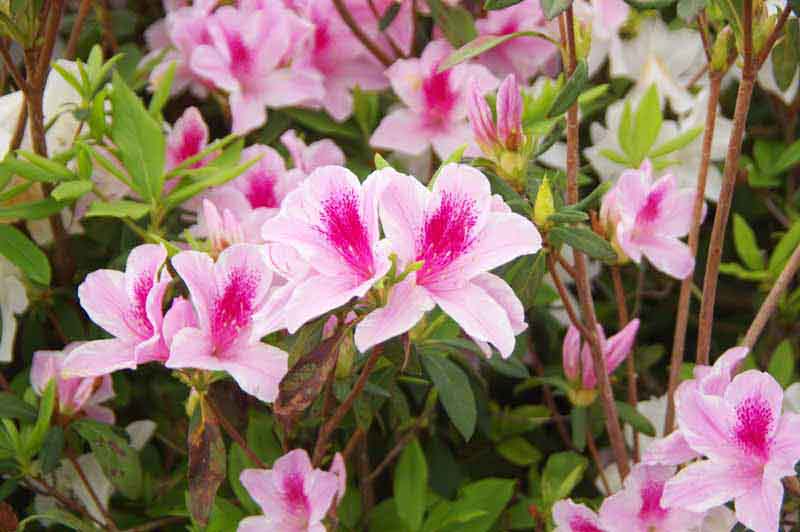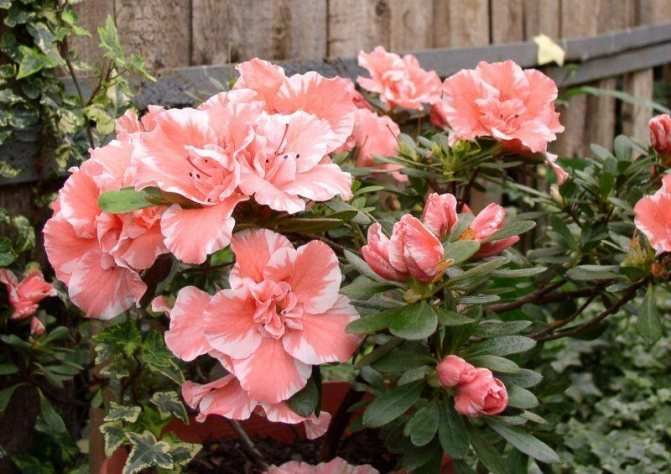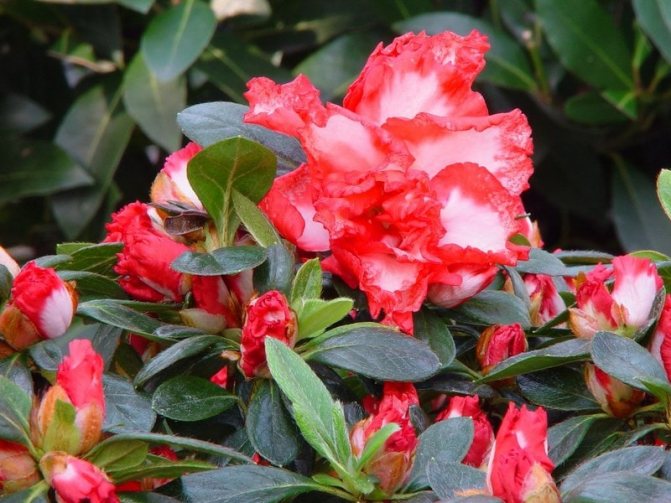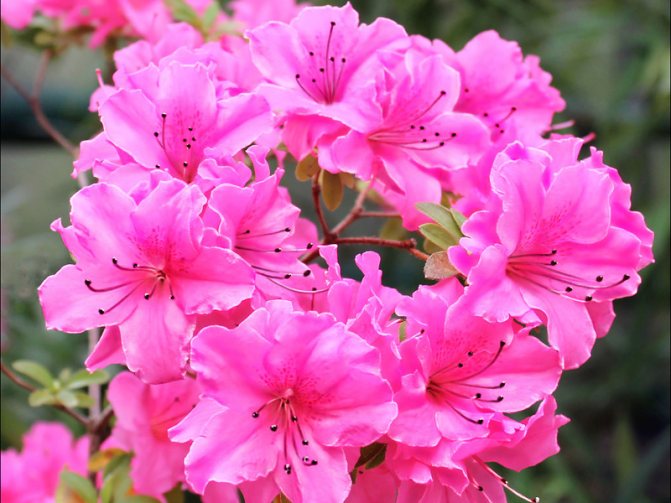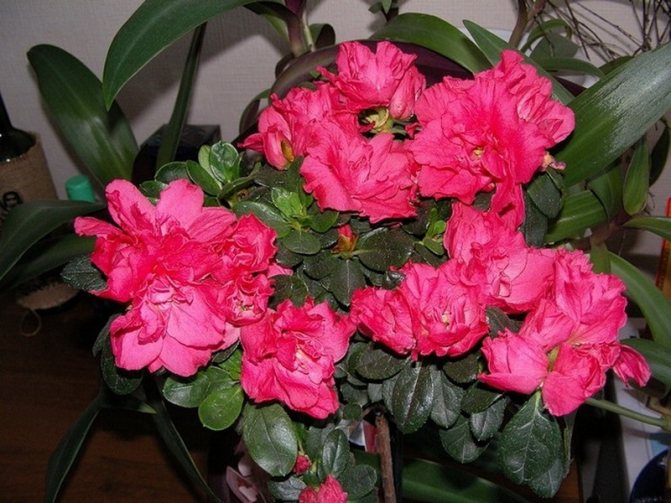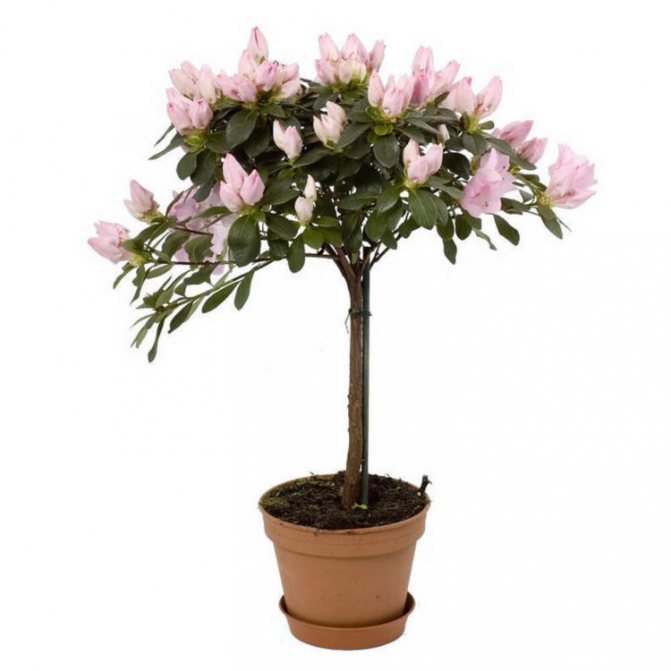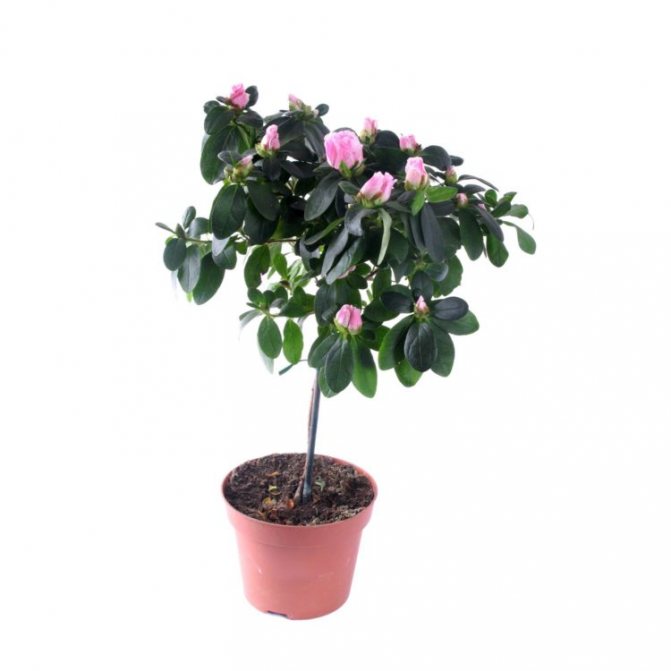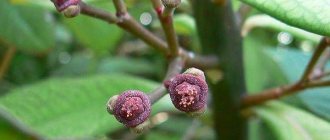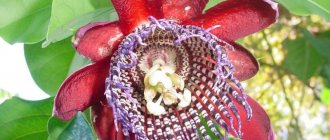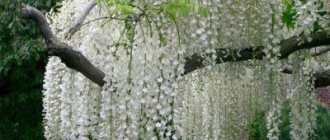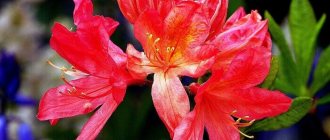Azalea simultaneously releases many buds, it is for its abundant flowering that many people fell in love with this flower. However, in most gardeners, the flower dies after a while. Azalea is very capricious, but if all the conditions for its maintenance are fulfilled, the azalea flowers will be lush and spectacular, and the houseplant itself will impress its owners for a long time. This is clearly seen in numerous photos of azaleas.
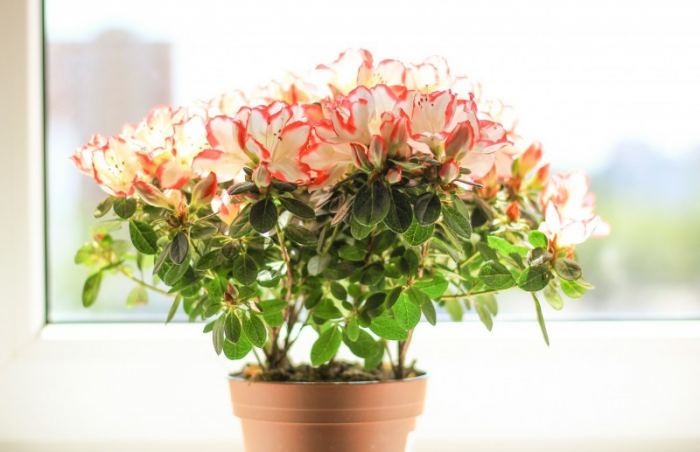
With proper care, azalea at home produces many buds, blooms brightly and for a long time, and azalea leaves will retain their rich green color.
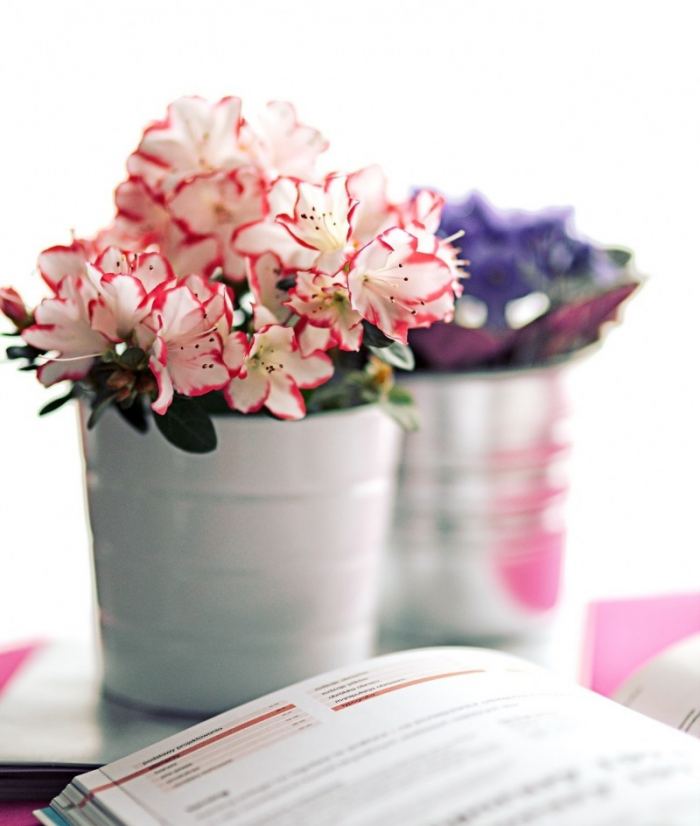

Temperature
Azalea care at home requires a special temperature regime. The flower is not thermophilic, so the normal temperature for it is 15-18 degrees Celsius. In winter, a temperature is required an order of magnitude lower - only 10-12 degrees Celsius.
What does the flower look like in the photo?
Here you can see a photo of an azalea grown on a trunk:
Humidity
The plant needs air with a high moisture content. To do this, the flower needs to be often sprayed with cool water from a spray bottle. It is recommended not to spray moisture directly on the flowers themselves, as they may begin to darken.


Additionally, open containers of water can be placed near the azalea, and in the summer, the flower can be taken out into the fresh air. In winter, when the air is dry, it is important to observe the moisture conditions for the flower.
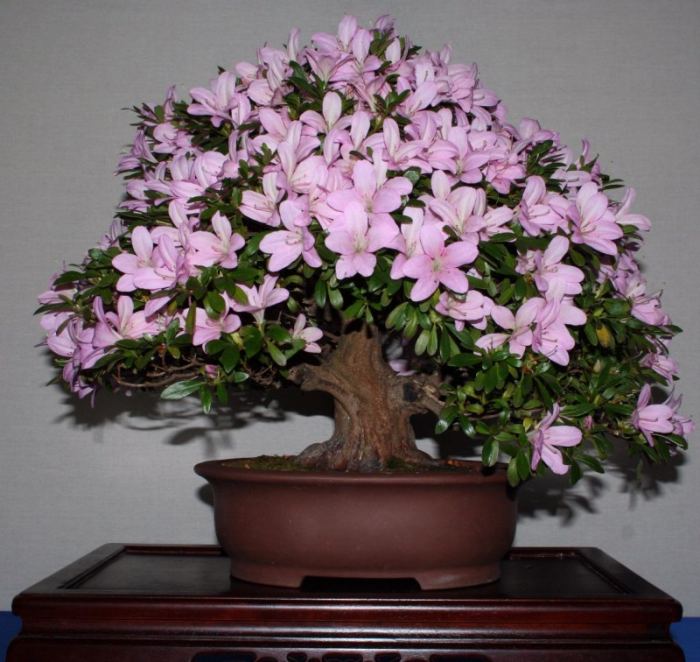

Species or varieties
Indoor azaleas most often there are two types - an Indian azalea (Sims rhododendron) and Japanese azalea (blunt rhododendron).
Azalea - Sims rhododendron (rhododendron simsii) small evergreen shrub up to 50 cm high. Young shoots are almost always covered with flat, chestnut-brown or bright red bristly hairs. The leaves are small (3.5 cm in length), leathery, the upper surface is dark green, and the lower one is light green, covered with reddish hairs. Leaves are short-petiolate. Flowers are collected in inflorescences, can be double or non-double, wide-funnel-shaped (3-5 cm in diameter), open at the same time. The color of Indian azalea can be from white to bright red. Often, the azalea flower is two-colored: white with a pink center, with a border around the edge, and also speckled.
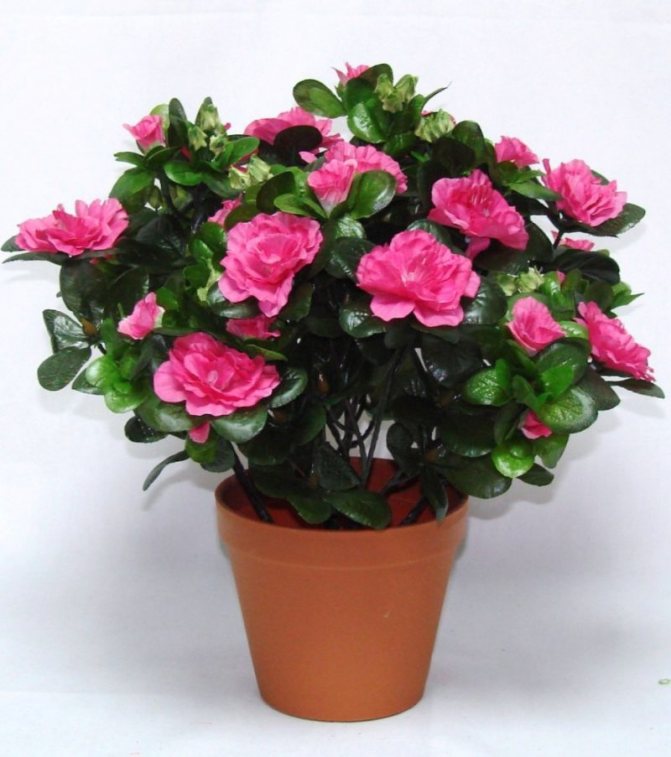

Azalea - Sims rhododendron (rhododendron simsii)
Japanese azalea occurs as a pot culture much less frequently. It is also a short shrub with small shiny leaves from 3 to 5 cm in length. It blooms profusely with small (up to 3 cm in diameter) flowers. Funnel-shaped flowers of different colors.
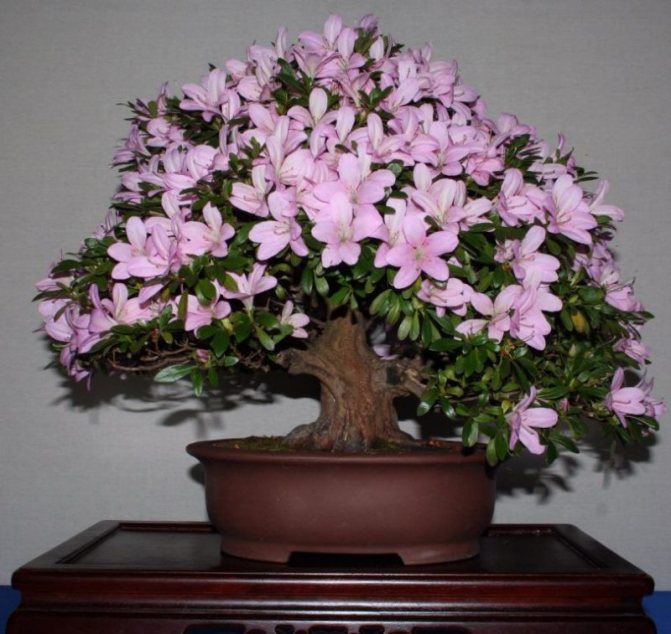

Japanese azalea
Watering
The growth of the shrub and its flowering depend on the irrigation regime. Azalea in this regard is especially demanding.
- Watering should be carried out systematically, and during flowering - especially abundantly.
- Do not allow the soil to dry out in the pot.
- The substrate at the bottom should be constantly moist, but without excess water.
- It is unacceptable for water to remain in the pan - always get rid of it.
- Always water only with water that has settled for at least two days. Melted water is ideal for irrigation.
- A couple of times a month while watering, you can add 2-3 drops of lemon juice.
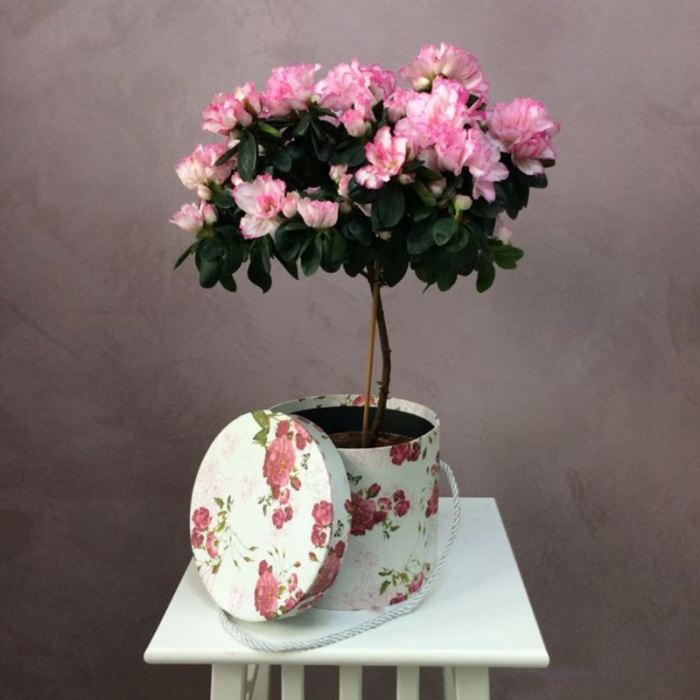

Pros and cons of this method of growing rhododendron
Stamp azalea is classified as a capricious plant that requires a special attitude towards itself. The cultivation and care process has a number of positive and negative aspects.
Pros:
- Compact form.
- Thanks to its decorative properties, it becomes a decoration of any room, garden or loggia.
- Can be grown with different flowering times.
- Grows well as a bonsai.
Minuses:
- It is difficult to get used to new conditions.
- A certain mode of watering, lighting and feeding is required.
- Timely correct pruning of the bush is required.
Important! Another significant drawback of the plant is formed for a long time, over several seasons.
Pruning azalea
After the flowering period, all wilted flowers are harvested. In early spring, young stems are cut with a special pruner and carefully pinched. Azalea throws out new leaves half a month after the last pruning.
Growing difficulties
- Wrinkling and falling leaves - insufficient watering. You can immerse the pot in a container of water several times a week until it is completely saturated. Low humidity can be other possible causes.
- Short flowering period - warm dry air. There may also be a reason due to bright sunlight and insufficient watering.
- Yellowing of leaves - clay soil or clay in water.


Transfer
It is necessary to transplant the azalea immediately after the first flowering. The earthen lump cannot be destroyed, it is carefully moved into a new pot using the transfer method, because the roots of this plant are thin and fragile, and because of this they are prone to injury.
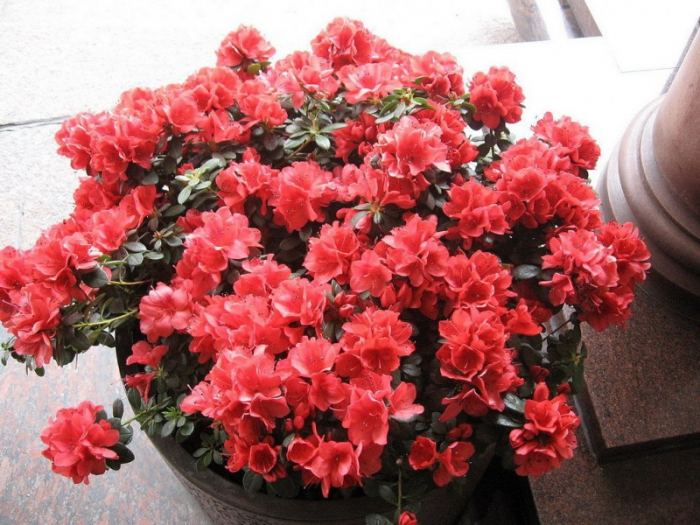

The pot should not be deep, it is important that the roots of the azalea are in contact with a constantly moistened substrate. Young plants are transplanted annually, and with age, the time between transplants increases to once every three years. During transplanting, you need to remove all dried plant elements.
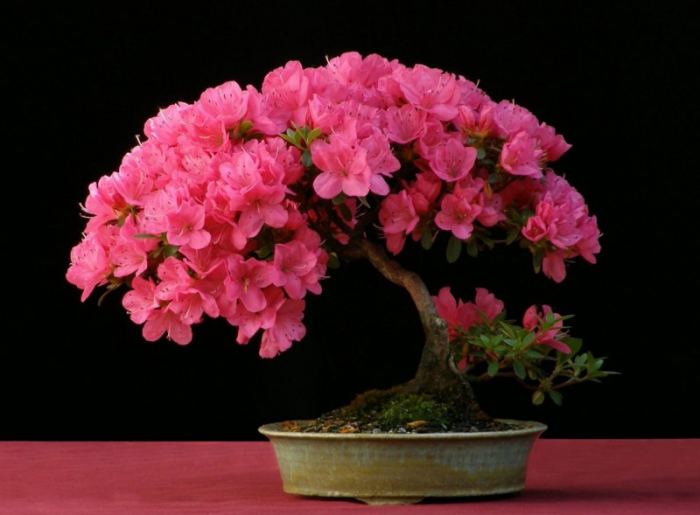

How to make a standard plant from an ordinary plant?
The stem is the part of the trunk of a plant that extends from the substrate to the branches. To create a standard azalea, the pruning method is used. The process consists of the following actions:
- Choose the most even and strongest branch for the trunk.
- Lateral shoots are cut.
- The skeleton of the trunk is regularly monitored. When new shoots appear, they are removed.
- For smoother growth, the tree is tied to a special bar and periodically the pot is turned around its axis.
- When the desired height is reached, the upper part is pinched. The azalea will start branching.
Then all efforts are directed to the formation of the crown of the tree. It is made round, elongated or pyramidal. It all depends on the desire of the grower.
Reproduction
Azalea propagation is carried out in the summer thanks to cuttings from the stems. It is necessary to choose stems beginning lignification with new buds. Then they are planted in the soil and covered with glass or polyethylene on top. Often and abundantly, cuttings are watered and sprayed with water.
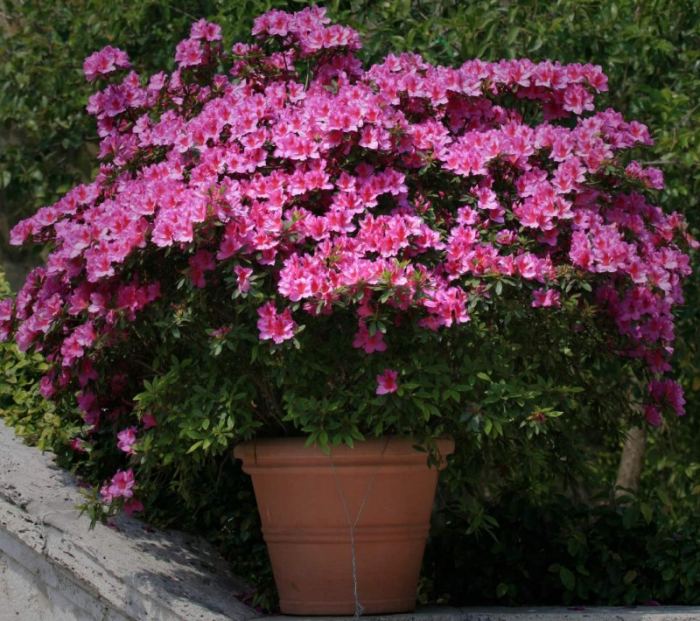

Emerging buds are immediately removed. After the cuttings take root after a few months, they are planted in a pot and, by pinching the shoots, they form the crown of the bush.
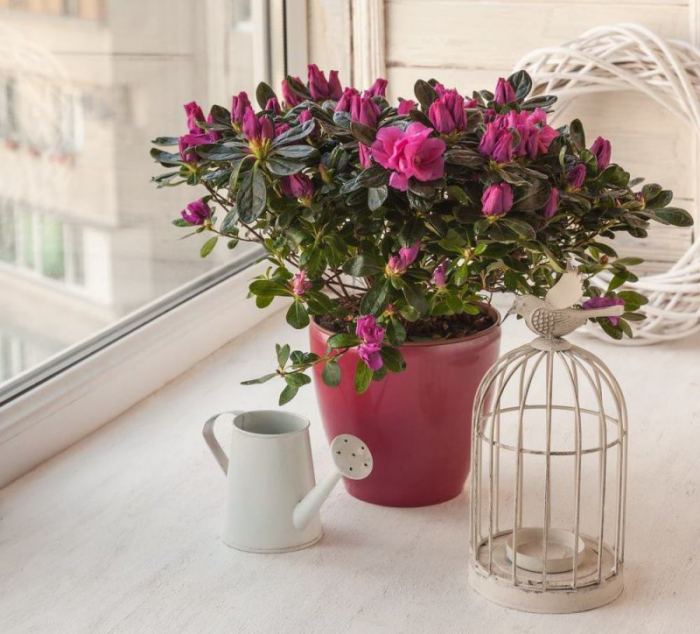

Propagation of azaleas by cuttings and division
It is most convenient to propagate the azalea by cuttings and dividing the bush. You can also get a full-fledged plant from seeds, but this process is very laborious and time-consuming.
Propagation by cuttings The best time to breed is during the spring months. To do this, use cuttings 7-8 cm long with a stiff trunk. The lower part of the cut must be treated with a rooting stimulator, since the cuttings of the azalea are very difficult to root. For 3-5 weeks, the stalk is kept in a glass with soil, covered with a film and constantly sprayed. As soon as the leaves appear, the plant is transplanted.


Propagation of azaleas by cuttings
Reproduction by dividing the bush For this method, an adult plant is taken out and the roots are freed from the substrate. You can divide the bush into 2 equal or several parts. In this case, you should be very careful with the roots, they are very thin and easily damaged. The separated bushes are planted in a mixture of peat and sand, watered regularly and kept in a warm place.
Diseases
The flower begins to ache due to lack of proper care or the presence of pests. The provoking factors are dry soil and air, direct sunlight, high temperatures, lack of lighting and improperly selected soil.
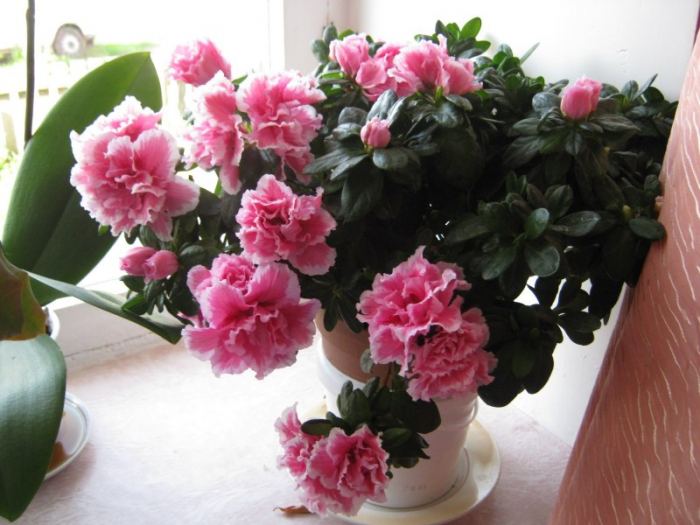

So, azalea leaves begin to turn yellow and wilt due to dry soil or excessive exposure to direct sunlight. The so-called "rust" and gray rot appear due to incorrect temperature conditions, and because of poor quality and unsuitable water for irrigation, azalea flowers wither and are discarded. If the plant is oversaturated with moisture, phytophthora appears, and the plant dies.
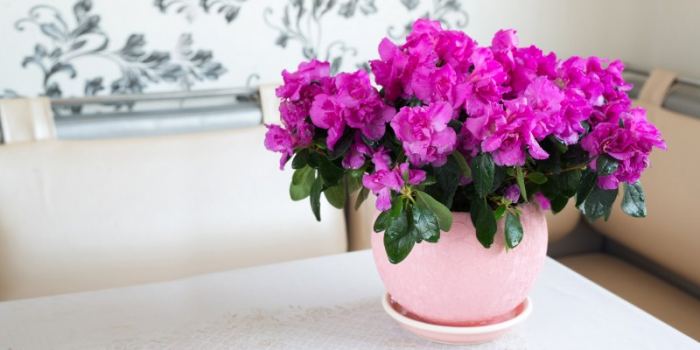

How to care for an Azalea
Most often, with inept home care, the leaves of the azalea begin to dry soon after purchase, the buds fall off and the plant gradually dies. This creates the feeling that it is difficult to create suitable conditions for the existence of this plant. However, it is not.
Azalea is a rather moody houseplant. But with the right content, it will delight you more than once with the abundance of its amazing colors. You need to know the features of keeping azaleas in indoor conditions and some rules for caring for this flowering plant, based on an understanding of the features of its life in natural conditions. We must imitate nature and provide plants with the ingredients they need.
Lighting
Azalea does not tolerate direct sunlight, it needs diffused light or partial shade. In summer, it is recommended to take it out into the open air, avoiding the scorching sun. It is best to dig in with the pot in the garden in a thin shade. Good summer rain for azaleas is quite beneficial.
If the climate in your area is mild, then some varieties of azaleas can be grown outdoors, protecting them from frost in winter and enjoying the abundance of flowers in summer.
IMPORTANT: The plant should be kept out of direct sunlight, despite the azalea's love of the sun.
Air humidity
Azaleas need high humidity. If the azalea is in the apartment, then with the beginning of the heating season it becomes very dry in the rooms, and it is necessary to maintain high humidity: spray the plant regularly.
IMPORTANT: Daily spraying during flowering is a must. It is necessary to spray finely, as large spraying will leave stains. In case of impossibility of small spraying, it is worth refraining from the procedure altogether.


Watering
For azaleas, proper watering is very important.... The soil should not dry out. Neither waterlogging nor stagnation of water in the sump should be allowed. Ideal for irrigation - rain, melt or clear river water. In extreme cases, settled tap water.
It is recommended to acidify water for irrigating azaleas (several crystals of citric acid per 1 liter of water), so as not to lower the acidity of the soil. Water the azaleas with water at room temperature (by no means ice cold). In the fall, watering is slightly reduced.
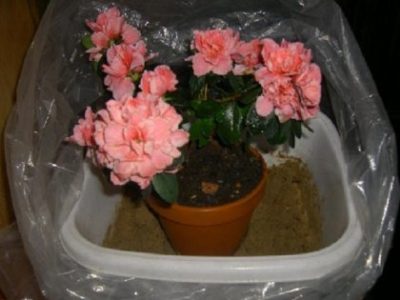

Since for the azalea
peat soil is well suited, which, when dry, turns into a solid lump and does not absorb water, it is useful to periodically immerse the pot with the plant in a large vessel with water for several hours... If the plant is large, just use a deep pan.
In no case should you loosen the soil, - azaleas have thin delicate roots that are easily damaged.
In cool greenhouses in winter, it is practiced to put ice or snow on the soil surface under the plant.The snow slowly melts and gradually permeates the ground with melt water. But in warm apartments, a large temperature difference between the roots and crown of the plant can adversely affect the blooming azalea.
Temperature
Azalea is very temperature sensitive. In winter, she needs a cool air temperature (12-14 ° C), but with proper care, they can grow at 20-22 ° C. If the azaleas have been relaxing in the garden in the summer, it is very important to move them to the apartment before the start of the heating season.
The soil
Azalea is one of the few indoor plants that requires acidic soil (pH 4-4.5). Heather soil is best suited for it, but you can replace it with a mixture of coniferous and peat soil (2: 1) with the addition of a small amount of river sand. Azalea grows well in hydroponics.
TIP: You can buy a specially prepared potting mix for acidophilic ("acid-loving") plants, which include azaleas, at a flower shop.
Transfer
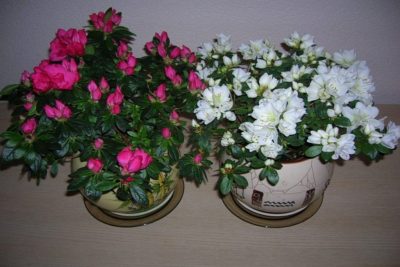

Young plants are transplanted annually, old ones every 2-3 years. When transplanting azaleas, it is undesirable to disturb the root ball; instead of transplanting, transshipment with the addition of fresh substrate is recommended.
Since the root system of the azalea is superficial, as a dish use only low pots.
Fertilizer
It is better not to experiment with fertilizers for azaleas, but to buy specialized fertilizers and apply them according to the instructions. The only rule to follow when feeding is to fertilize the azalea only during flowering.
Bloom
To achieve abundant flowering you need to cut and pinch the stems in a timely manner. Pruning begins in May. Young shoots are pinched, leaving 4-5 leaves on them. When small young shoots appear near flower buds, they must be plucked out.
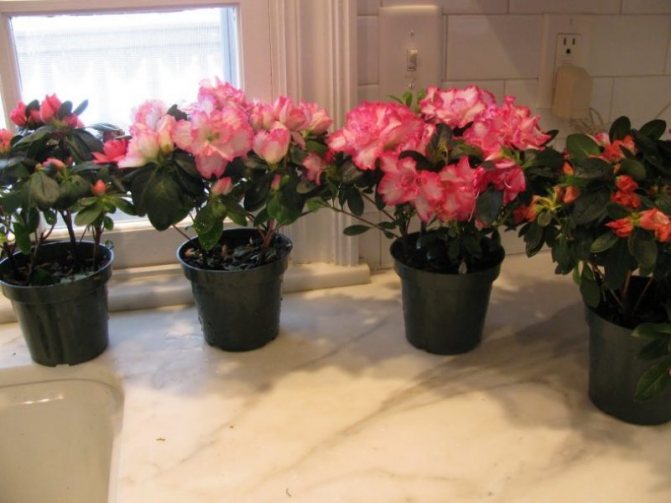

Remember: the more lush the bush, the weaker the flowering.
For longer flowering you also need to keep the azalea cool. Flower buds in the process of development and swelling release buds - 2-4 buds from each bud. During flowering, all faded must be removed immediately, then the azalea will bloom longer. When flowering, remove the seed pods so as not to weaken the plant.
Unlike many other plants azalea during flowering can be rotated and carried, the buds will not fall off from this... With careful care, the azalea blooms more and more magnificently from year to year.
TIP: In order for the buds to develop and bloom, you need to monitor the appearance of new shoots next to them, and remove them.
Azalea in bonsai culture
The most beautiful bonsai are the creations of nature. A person makes a lot of effort and time to repeat these forms. Bonsai-style azaleas and rhododendrons are most commonly found today in a traditional, upright form. But they can be formed in a cascade, a spiral, with the main branch tilting in different directions. The main pruning to give the plant the desired shape is carried out from early spring to early summer. At this time, the bush is the strongest. It is important to remember that lateral branches, with frequent cutting off the top, become dominant and grow faster. This can weaken the tree. The top is only cut to shape the plant.
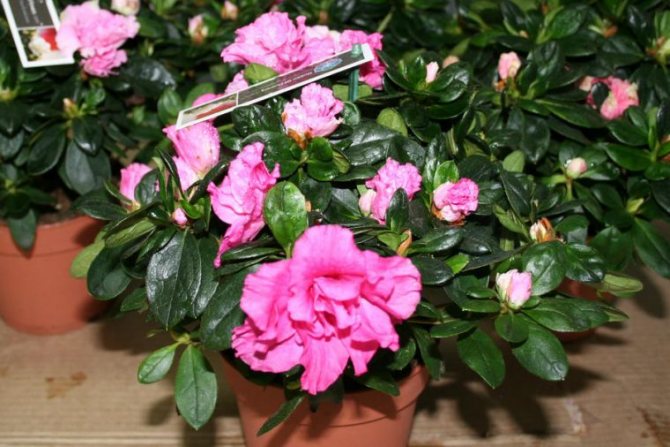

Soil, fertilizers
Experts offer a proven soil composition for effective flower cultivation, taking into account its biological characteristics. Among the numerous proposals, a fresh composition is chosen for carrying out specific actions: planting a plant in the main place, sowing seeds for seedlings. They differ in the content of mineral elements. With long-term storage of soil, the chemical composition changes.
If the soil for azaleas is prepared independently, then it must be borne in mind that an acidic environment is necessary for the life of the fungus on the roots of the plantinvolved in the supply of nutrients during the growth of azaleas.
An alkaline environment leads to their death, and then to the destruction of the entire plant. The acidity of the soil for azaleas has a pH value of 3.5 to 5.5 units. The following composition is considered optimal, which includes six soil options: two parts of leafy, coniferous land, one part of lowland, high-moor peat, heather land, sand.
For feeding azaleas, it is recommended to use well-known complex fertilizers of balanced composition for a specific type of plant, for example, Uniflor-Buton, Kemira-Lux. The presence of an optimal amount of iron and magnesium chelates helps in the prevention of leaf chlorosis.


Recommended fertilizer for azalea
It is convenient to combine top dressing with watering plants once every ten days at the rate of 20 g per 10 liters of water. It is recommended to do this during the period of bud formation, opening of flowers in the form of root, foliar dressings. Fertilizer is applied for the first time not earlier than three weeks after planting.
Make sure the fertilizer expiration date is valid. Expired sachets will cause irreparable harm to the azalea.
Now we offer ready-made forms of liquid fertilizers, created from natural humic compounds with the addition of micro and macro elements. They help the formation of a powerful root system, improve the decorative qualities of the flowering crown.
As organic fertilizers, a solution of high peat is often used, a small amount of rotted manure, preferably in the form of a diluted slurry.
Regular feeding is beneficial when sowing seeds, growing seedlings, while growing plants in a permanent place.
How to propagate?
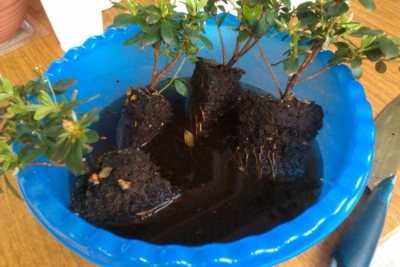

There are several ways to breed, such as:
- using seeds;
- cuttings;
- vaccination;
- dividing the bushes (as a rule, an old plant with a large number of shoots is used).
Breeding azaleas with seeds is not effective, this method is rarely used. A more effective method is to propagate azaleas using cuttings. The process consists of several stages:
- Choosing a cutting. The stalk should be 5-7 months old. Remove the buds, leave 3-4 leaves at the top. The length of the handle is 6-7 cm.
- Cutting preparation. Treated with a non-concentrated solution of potassium permanganate.
- Preparing the landing site. Pebbles are laid out on the bottom of the container, and soil on top. The soil is well watered before planting.
- Landing in the ground. Planted in 3-4 pieces in a pot, planted in abundantly watered soil at a distance of 4-5 cm from each other. Planting depth 2-3 cm.
- Creation of conditions for growth. Cover the cuttings with a film, moisten the soil from time to time and air the cuttings daily. Such breeding is laborious, but gives significant results.
What problems can arise during the growing process
A whimsical plant can bring many problems, but pests are one of the main ones. The main ones are:
- Furrowed weevil - enters the soil with water, in the form of larvae and eggs. During the day, insects hide, and at night they destroy the bark of the stems, the edges of the leaves. The larvae eat up the roots, which is why the leaves begin to dry out;
- Strawberry mite - affects the upper parts of plants. A characteristic feature of a tick lesion is the folding of young leaves into a kind of boat, buds are crushed, and new leaves are deformed. The growth rate slows down, flowering stops;
- The greenhouse whitefly is a dangerous vector of viral diseases. When affected by them, the stem begins to lose color, the leaves wither. Sticky mucous discharge appears on the surface;
- Greenhouse thrips - reproduction occurs on the lower part of the leaf, where larvae develop and adult insects feed. As a result of their vital activity, brown spots and black dots appear on the sheets - traces of excrement. The bud begins to turn yellow, lags behind in growth. Insects are most dangerous in the warm season;
- Slugs - appear on plants late in the evening or at night.Gnaw holes in leaves, destroy petals, leave behind a distinctive silvery mucus;
- Greenhouse aphid - provokes the folding of leaves, inhibits growth and flowering;
- Citrus mealybug - attacks buds and flowers. Adults are located in the axils of the buds, scales and cracks in the bark. When infected with worms, the growth of leaves stops, they turn yellow and become covered with white cobwebs.
If the plant begins to wilt or marks appear on the leaves, it is recommended that you take all the necessary measures immediately. If the pests are not neutralized in a timely manner, there is a danger of the complete death of the rhododendron and infecting the neighbors in the garden.
Azalea on a trunk is a whimsical, but incredibly beautiful plant that will decorate any flower garden. With proper care, it will delight the owner with abundant flowering for many years.
You can learn more about growing azaleas by watching the video:
Description
Azalea Mix belongs to the genus rhododendron of the Heather family. The plant is short about 60 cm. A shrub with juicy dark green leaves. The leaves are round, pointed, oblong, the leaf surface is dense and smooth. Small flowers resemble a bouquet of roses. Lush bloom with proper care.
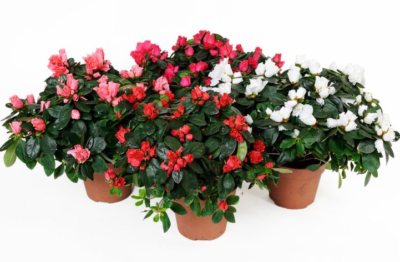

The color of the flower is varied, pink, white. The shape of the crown is domed, consisting of several flowers. The root is small and flat. Azalea is very popular among flower growers and is called indoor rhododendron. In translation, rhododendron means a tree with roses or a rose tree.
History of origin
Azalea Mix is a hybrid rhododendron. The homeland of natural varieties is India, China, Japan. At the beginning of the 20th century, indoor azaleas Mixes were bred by breeders. Wild azalea is found in the Himalayas. It was introduced to Europe at the end of the 18th century. More than 12 varieties of this plant have been created by breeders.
What is the difference from other types of rhododendron?
Unlike natural varieties, Mixes have little or no smell.
The main difference between the azalea flower and other rhododendron species is the number of stamens. The number of stamens coincides with the number of petals and cannot be more than five.
In rhododendrons, there are two per petal, while in other species there are more than 10. And the rest of the azalea from other species of rhododendron is impossible to distinguish.
When it blooms
Flowers on the bushes appear in winter, which enhances the attractiveness, the desire to see a blooming garden on your window.
Many flowers rest in winter... This is possible only with strict adherence to the temperature regime and other requirements of home care.
If the plant is waiting for transfer to the house on the balcony, plot, then this must be done gradually before the beginning of the heating season.
A temperature drop, a change in the humidity regime leads to the fall of foliage, emerging buds.
Home care
The culture is very demanding on the conditions of detention. The impact of unfavorable factors can lead to the early death of the bush. Especially you should monitor the plant during acclimatization in a new place, flowering and active growth.
Indian azalea care includes:
- creating and maintaining an optimal microclimate;
- regular watering;
- spraying the aboveground part;
- top dressing;
- pruning;
- periodic transplant;
- providing a rest period;
- protection from diseases and pests.
Requirements for the conditions of detention
- high air humidity, 70-80%;
- coolness, the temperature in summer is not higher than + 25 ° C, from October to December + 6 + 10 ° C, January-February + 10 + 15 ° C, in the spring, during flowering, + 17 + 20 ° C;
- bright diffused light;
- acidic substrate;
- soft water for irrigation;
- regular watering.
This plant will feel great in a winter garden, in a greenhouse or on a frost-free loggia.
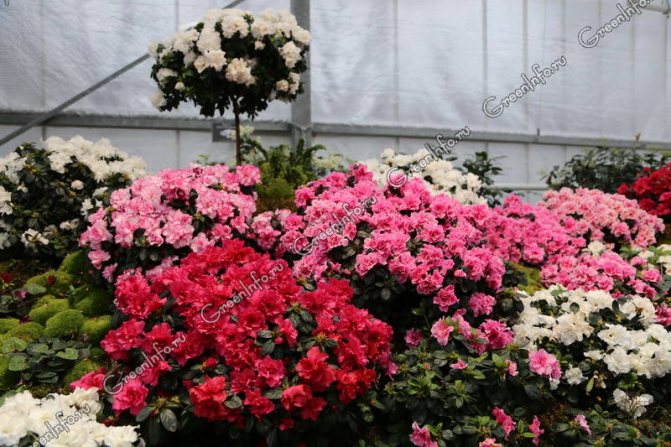

Indian Azalea (Azalea indica)
Photo
Below you will see what the rhododendron looks like in the photo:
Azalea in the interior of the house:
A blooming azalea in a pot is used instead of a bouquet of flowers. In the room, it can be used as a piece of furniture by putting a flowerpot in a beautiful flowerpot or in a hanging basket. It also looks exquisite on the window, but the sun's rays harm the leaves, so you need to focus on the north side. Azalea bonsai in the hallway or hallway is a sign that the owners not only love flowers, but also have good taste. Rhododendron is not difficult to shape in bonsai style and enjoy the beauty of the tree on cold winter evenings. But this is the pinnacle in the science of floriculture. First you need to learn the usual rules for caring for this plant.
Features of winter care
The optimal temperature in winter for azaleas is considered about 15 degrees, reminiscent of the misty warm season of early autumn. Dry air coming from working heating devices in apartments leads to the destruction of the azalea.
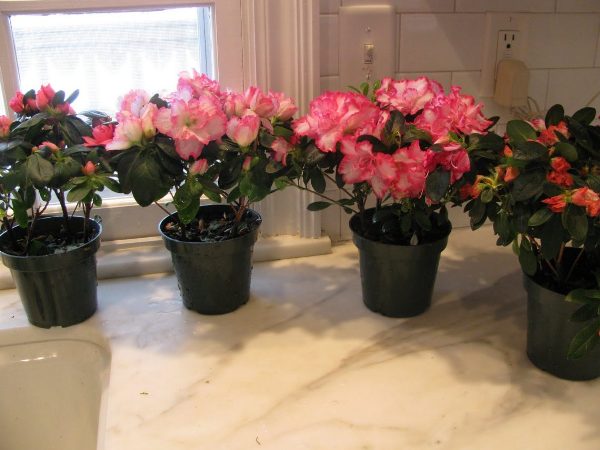

Azaleas under additional lighting
The flower tolerates the summer heat more easily on a closed balcony, loggias on the west side of the house. At the time of flowering, the azalea is allowed to turn, transfer to another place. The buds will not fall off like some houseplants.
In winter, during the flowering period, the requirements for the amount of light increase. Additional lighting created by various types of artificial lamps compensates for the lack of daylight in a timely manner.
Advice on using cold ice cubes to lower the temperature from working home heating systems must be applied with caution. Its rapid fall will lead to the shedding of buds, flowers.
History of origin
Azalea indica is considered the main ancestor of indoor rhododendron varieties, from which the rest of the hybrids were obtained. Azalea was introduced to Europe in the 16th century from China and Japan. By the 20th century, there were more than a thousand varieties of rhododendrons in culture.
Specifically, the Indian azalea was obtained as a result of interspecific and hybrid crosses of the Sima rhododendron. Indian azalea came to Russia as a gift to the royal family and was initially kept exclusively in court greenhouses.
Terms and conditions for blooming buds
Homemade azaleas Mixes traditionally bloom in spring - bright and luxuriant. With proper care, winter bloom can be achieved - January - February. Flowering is long - lasts about 30 days.
Before flowering, at the time of the ripening of the buds, you need top dressing and good watering. After flowering, in the summer heat, the pots are placed on the balcony; Azalea Mix does not tolerate high temperatures. After flowering, flowers and dry leaves are removed from the bushes immediately.
After 1 - 2 weeks, when young leaves appear, the tops need to be pinned - the first time in May, then in the summer, repeat the clothespin 2 times. This procedure forms a beautiful crown. Before and after flowering, Azalea Mix takes a cold shallow scattered shower well.
Indoor Azaleas Mix requires a cool place for good flowering, especially in summer. With the help of a shower, you can lower the temperature by 2 - 3 ° C. Be sure to shade the windows at noon.
The consequences of improper care
Improper plant care is fraught with negative consequences. Most often, it consists of the following:
- Improper watering. If the basic rules for watering are not followed, problems such as:
- fungal diseases (over-watering);
- root rot (excessive watering);
- spider mite (insufficient watering and dry air).
- Root damage (mechanical and chemical).
- Unbalanced feeding. They are expressed in a deficiency or excess of nutrients.
- Soil salinization (watering with untreated tap water containing an increased amount of salts).
- Violation of the temperature cycle. Leads to little or no flowering.
How to deal with this?
For example:
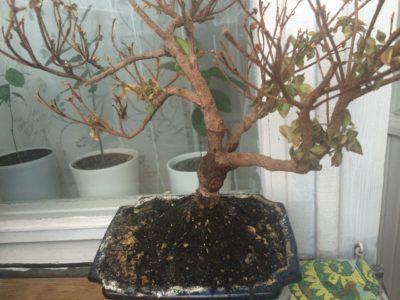

If the azalea has undergone a fungal disease, you need to treat it with special antifungal agents and ensure proper watering.- When the roots rot, the soil moisture should be reduced, the room should be ventilated more often and the plant should not be overheated. In such cases, the plant is treated with Fundazol or Oxyhom.
- If the azalea is affected by a spider mite, aphids and other pests, it is important to treat it with the necessary preparations in a timely manner.
- If you have problems with poor flowering or its absence, it is worth normalizing the temperature regime.
More information about pests and azalea diseases can be found here.
Despite the fact that the azalea on the trunk is a rather capricious plant, you should not deny yourself the pleasure of growing it. Clearly following the recommendations, it is quite possible to grow a wonderful tree with your own hands. And having received the first experience, then this wonderful hobby will be given much easier, and please with a riot of lush flowers.
Flowering Indian rhododendron
When and how does it happen?
The active flowering of Indian azalea occurs in the winter-spring period. It begins to bloom in December and can delight with bright flowers until May. A prerequisite for early flowering is the swelling buds that form on the stems of the plant.
How to care?
In order to ensure the most lush flowering of Indian azaleas, it will be useful to perform pinching, which consists in removing young shoots. This should be done so that the plant concentrates its energy on the blossoming buds, and not on new shoots.
After flowering, you should carefully remove all dried buds.
What if it doesn't give flowers?
Several factors can affect the lack of flowering in Indian azalea:
- soil not suitable for the plant;
- lack of nutrients;
- excessively high temperature, which prevents buds from setting.
It is very important to ensure that the plant is in a comfortable environment for it.
Difference from other rhododendrons
Cultures belong to the same genus, therefore they are very similar in appearance. The main differences are not typical for all varieties, exceptions are possible. The decorative forms stand out especially. The azalea indica mix is small in size and multi-colored flowers. The species can be evergreen or deciduous.
Table 1. Main differences
| Parameters | Azalea | Rhododendron |
| Where to grow | Home conditions, open ground | Open ground |
| The size | 30-50 cm | 1-2 m |
| Number of stamens | 5 | 10 and more |
| Leaves | Thinner, softer, more pointed | Depending on the variety, large, hard, rounded |
| The reverse side of the sheet plate | You cannot see the scales with a magnifying glass. | Small-leaved varieties have small, rounded scales. |
| Pubescence | None, possible exception - young shoots | May be on leaves and other parts of the plant |
Prevention of possible problems
- The leaves began to fall off - the roots are suffering from drought, it is required to adjust the watering.
- With a lack of nitrogen, the leaves will turn yellow and lifeless - fertilizing with special fertilizers is required.
- The leaves are shriveled - you need to increase the humidity of the air, spray the bushes with cool water.
- From chlorosis, necrosis and late blight, additional feeding of the flower with iron chelate is needed. If the substrate is not suitable, it will need to be replaced. Also, for preventive purposes, you can spray the bushes with phytoverm
Azalea Mix is a gentle and capricious tropical dweller. He needs careful, special care and attention.
If you find an error, please select a piece of text and press Ctrl + Enter.


